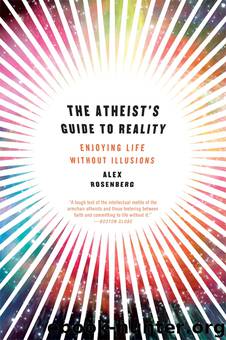The Atheist's Guide to Reality by Alex Rosenberg

Author:Alex Rosenberg [Alex Rosenberg]
Language: eng
Format: epub
ISBN: 9780393083330
Publisher: W. W. Norton
Published: 2011-09-25T16:00:00+00:00
FIGURE 8. Stop sign and yield sign
Could the Paris neurons be about Paris the way red octagons are about stopping? This is the theory impressed on us by introspection of our own thoughts about Paris—and about stop signs for that matter. In fact, the more consciousness thinks about it, the more certain we are that the shapes and squiggles outside our head are about stuff because of the way the thoughts in our head are about them.
This can’t be correct, not if thoughts about stuff are sets of neurons wired together (and they can’t be anything else). It’s not hard to show why, although it will take several steps. We’ll take it slowly, step by step, using common sense, and come to a deeply uncommonsense but utterly compelling conclusion.
Red octagons are about stopping because someone (in fact, a committee in the state of Michigan in 1915) decided that thereafter, in Michigan at any rate, they would mean ”Stop!” There is nothing that is intrinsically “Stop!”-ish about red octagons. Downward pointing yellow triangles—yield signs—could have been chosen as stop signs instead. Red octagons are about stopping because we interpret them that way. We treat them as symbols for the imperative variously expressed in English as “Stop!,” in Greek as “σταματάω!,” and in Chinese pictograms as “停止.” The Greek and Chinese inscriptions don’t mean “Stop!” to us non-Greek and non-Chinese readers because we don’t interpret them as being about stopping. The point is that a red octagon or any other clump of matter—ink marks on paper or pixels on a screen—is about something else only because it has been interpreted by someone to be about it.
Let’s suppose that the Paris neurons are about Paris the same way red octagons are about stopping. This is the first step down a slippery slope, a regress into total confusion.
If the Paris neurons are about Paris the same way a red octagon is about stopping, then there has to be something in the brain that interprets the Paris neurons as being about Paris. After all, that’s how the stop sign is about stopping. It gets interpreted by us in a certain way. The difference is that in the case of the Paris neurons, the interpreter can only be another part of the brain.
Let’s see exactly why. Call that part of the brain the neural interpreter. It’s supposed to interpret the Paris neurons as being about Paris the way we interpret the red octagons as being about stopping. How can the neural interpreter interpret the Paris neurons as being about Paris? The interpreter neurons would have to have different parts that are about two different things, about Paris and about the Paris neurons. Already we can see trouble coming. We started out trying to explain one case of neurons being about something—Paris. Now we have two cases of neurons being about things—about Paris and about the Paris neurons.
Why does the neural interpreter have to be both about Paris and about the Paris neurons? Because somewhere inside the
Download
This site does not store any files on its server. We only index and link to content provided by other sites. Please contact the content providers to delete copyright contents if any and email us, we'll remove relevant links or contents immediately.
From Bacteria to Bach and Back by Daniel C. Dennett(2153)
The God delusion by Richard Dawkins(1861)
Boy Erased by Garrard Conley(1417)
THE SELFISH GENE by Richard Dawkins(1324)
The Falls by Unknown(1148)
the god delusion by richard dawkins(1088)
Christopher Hitchens by The Portable Atheist: Essential Readings for the Nonbeliever(1073)
THE GOD DELUSION by Richard Dawkins(1058)
Drunk with Blood: God's Killings in the Bible by Steve Wells(1049)
Triumvirate of Rationalism: Thomas Paine, Thomas Jefferson, and George Orwell by Christopher Hitchens(1036)
Outgrowing God by Dawkins Richard(1034)
About the Holy Bible by Robert G. Ingersoll(1025)
Atheism: A Very Short Introduction by Julian Baggini(1001)
The Rage Against God by Peter Hitchens(994)
The Atheist Muslim by Ali A. Rizvi(987)
Why I Am Not a Christian and Other Essays by Bertrand Russell(940)
Battling the Gods by Tim Whitmarsh(932)
Emancipation of a Black Atheist by D. K. Evans(925)
God Is Not Great by Christopher Hitchens(922)
